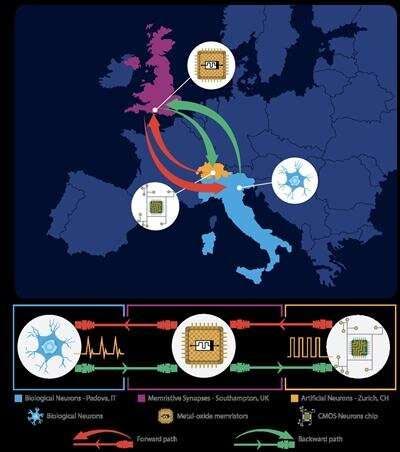Artificial neurons have been able to communicate with biological neurons via the Internet
Currently this project is still in the early stages of development and testing on animals, but shows great promise. In the aforementioned experiment, the scientists cultured a mouse's neuron in a lab at the University of Southampton (UK). These neurons are used as an intermediary for signaling the artificial nanoparticles attached to it, called memristors, which receive stimulation and processing information. Similar neuron models were also cultured in laboratories in Italy and Switzerland. The team then tried to get these neural models connected. The result was surprising, not only did neural models establish links with each other, but they could also be able to transfer information back and forth using an internet connection.

Although the amount of data transmitted is still quite limited, the experimental results are a simple demonstration that artificial and artificial biological neurons can communicate 2-way with each other and in real time.
Stefano Vassanelli, a professor of biomedical sciences at the University of Padova, Italy, a member of the research team, said: 'For the first time, we have demonstrated that artificial neurons on processing chips can be coupled. connect with biological neurons in the brain and interact with each other through 'nano memories' capable of simulating the basic functions of real nerve tissue. The natural connection between such neurons can allow the transmission of signals between neurons that handle most of the processing in the brain . '
The 'hybrid' brain, which Professor Vassanelli describes, holds great promise in opening up the possibility of interaction between real human intelligence and artificial intelligence (AI). At the same time, it plays a role as a potential method of treatment and rehabilitation for brain-related diseases such as Parkinson's, stroke or epilepsy. After being implanted into the brain, silicon neurons will act as a type of synthetic nerve, in which they are responsible for stimulating and adapting natural neurons that are disturbed by pathology, creating conditions rehabilitation conditions.
You should read it
- Watching pictures painted by artificial intelligence, everyone thinks that is the work of a true artist
- Artificial intelligence learns to create another artificial intelligence, replacing people in the future
- 6 steps to start learning artificial intelligence programming (AI)
- [Infographic] Benefits and hazards from Artificial Intelligence
- What happens if aliens are artificial intelligence?
- How can the AI see us behind the walls?
 New face recognition technology can identify objects up to 1,000 meters away
New face recognition technology can identify objects up to 1,000 meters away The new 3D printing technique can create delicate, small, soft objects in seconds
The new 3D printing technique can create delicate, small, soft objects in seconds This device can turn you into 'Spider-Man'
This device can turn you into 'Spider-Man' Toshiba's algorithm helps normal computers calculate faster than supercomputers
Toshiba's algorithm helps normal computers calculate faster than supercomputers China successfully developed 'handheld' quantum satellite communications equipment
China successfully developed 'handheld' quantum satellite communications equipment This is the first watch to integrate two in-depth health monitoring tools
This is the first watch to integrate two in-depth health monitoring tools